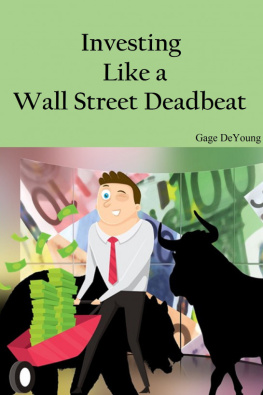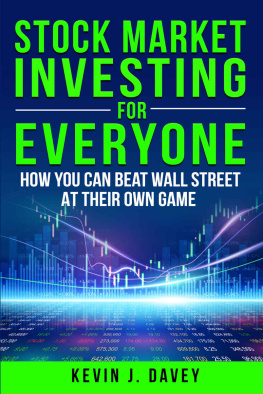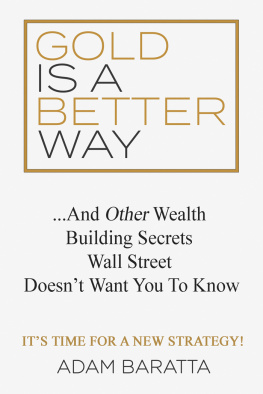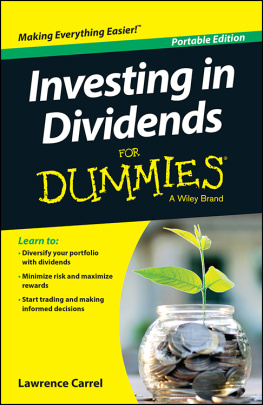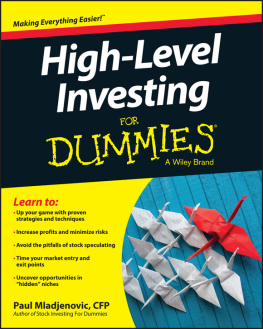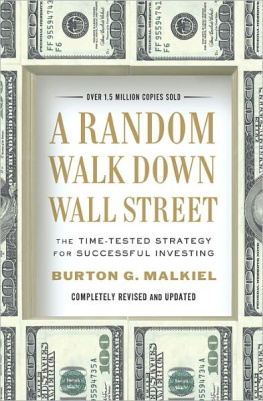Investing Like a Wall Street Deadbeat
Copyright 2017 Gage DeYoung
Published by Gage DeYoung at Smashwords
Smashwords Edition License Notes
This ebook is licensed for your personal enjoymentonly. This ebook may not be re-sold or given away to other people.If you would like to share this book with another person, pleasepurchase an additional copy for each recipient. If youre readingthis book and did not purchase it, or it was not purchased for yourenjoyment only, then please return to Smashwords.com or yourfavorite retailer and purchase your own copy. Thank you forrespecting the hard work of this author.
For Caleb and Paden.
Never be afraid to do the right thing.
Beware of littleexpenses.
A small leak will sink agreat ship.
Benjamin Franklin
Table of Contents
Acknowledgements
This guide is a result of more than 2 decades ofprofessional experience obtained in the investment servicesindustry and collaboration with hundreds of affluent investors.
I would like to thank the firms that previouslyhired me to represent them and all my colleagues that helped makeprevious roles manageable and enjoyable. Most of all, thank you tothe families that I have had the pleasure of collaborating withthrough 2 of the most volatile and challenging decades in all ofinvestment history. Your trust in me is greatly appreciated.
Prologue
Warren Buffet has advised investors tostick with low-cost index funds. Regarding his recent annualletter to shareholders he stated When trillions of dollars aremanaged by Wall Streeters charging high fees, it will usually bethe managers who reap outsized profits, not the clients.
During the last couple of years, I have comeacross articles suggesting the annual long-term return forecast forstocks, bonds, and cash may be significantly lower over the nextdecade than we have seen on average for the previous 4 decades.This forecast is primarily a result of an artificially low interestrate environment created by central banks and the resultingappreciation in value of both stocks and bonds over the previous 8years.
It is evident to me that we can no longerafford to be giving up 1 or 2 percent of our investment portfoliosin the form of fees and expenses if we ever wish to achieve thegoal of financial independence.
When you do the math, you may be shocked tosee that one of the greatest annual expenses you have in yourhousehold are the fees and expenses you pay on your investmentportfolio. The reason this occurs is that you dont see all theexpenses and charges that are removed. Much like unseendepreciation of a car, you dont see the erosion of your investmentportfolio caused by the combination of internal expenses andinflation.
We cant do much about inflation but we cando something about expenses.
Why Low-Cost Investing May be aRequirement
Charles Schwab recently released its updated2017 long-term return forecast for stocks, bonds and cash throughthe article WhyMarket Returns May be Lower in the Future by VeerapanPerianan. I have come across this presentation each year for thelast three years and these alarming forecasts are one of thereasons I decided to become an independent financialrepresentative. I wanted to help prudent investors proactivelyminimize the expenses and fees associated with their investmentportfolios.
The article presents a chart of five assetand sub-asset classes along with their average annual returns forthe previous 46 years compared to their reduced annual forecastreturns for the next decade. The forecast calls for an expected1.7% to 4.4% reduction in the performance of all the asset andsub-asset classes presented.
The article goes on to provide three primaryreasons for the lower return forecast estimates: low inflation, lowinterest rates and high current stock valuations as indicated byhigh respective price to earnings ratios.
What does this mean? It means we shouldexpect lower returns from our investment portfolios, but I was alsocurious how this forecast translated to a typical diversifiedportfolio that may be held by an average investor.
Fidelity Investments builds their modelBalanced Portfolio with 50% in stocks, 40% in bonds and 10% in cashor short-term holdings. These are 3 of the asset classes presentedin the Schwab article however the article further separates stocksinto 3 sub-asset classes: domestic large-cap, domestic small-capand international large-cap. I separated the 50% stock allocationto be similar in structure to a Balanced Sub-Asset Class IndexPortfolio Model that I present in another chapter about rebalancingand created the model below.
A Balanced Model Portfolio
27% Domestic Large-Cap Stock
3% Domestic Small-Cap Stock
20% International Large-Cap Stock
40% Domestic Investment Grade Bonds
10% Cash
I then applied Schwabs historical (1970 2016) performance data and forecast (2017 2026) performance datato determine the net effect on the portfolio. A Portfolio built perthe model would have achieved an annual average rate of return of8.35% from 1970 through 2016. The annual forecast for the nextdecade (2017 2026) for that same portfolio is 4.84%, a differenceof 3.51%.
Now couple this return forecast (-3.51%)with the kinds of fees and expenses we typicallysee applied to our investment portfolios. According to Lipper, theaverage mutualfund charges aninternal expense ratio around 1% annually and according toPriceMetrix the average advisor charges 1% annually. Put themtogether and you could be losing another 2% or more of yourportfolios value to fees and expenses every year.
It is hardly worth theinvestment risk taken to achieve an average annual rate of returnof 2.84% (excluding inflation) over the next decade. Per the Schwabarticle, inflation averaged 4% from 1970 through 2016 and isforecast to be 1.9% for the next decade (2017 2026). If we everwish to invest our way to financial independence, we mustparticipate in efficiently allocated low-cost portfolios that mayprovide returns beyond inflation.
There are certainlyportfolio return forecast headwinds working against us, but if weproactively minimize the fees and expenses associated with ourinvestment portfolios, the odds of getting ahead will swing more toour favor.
Adopt a Wall Street DeadbeatMentality
We are usually quite proudof ourselves when we manage to save money on our purchases whetherbuying something on sale or using a coupon. Contrarily, we get abit outraged when we receive a penalty fee from a company we areusing for our needed services. Why is it that we dont apply thismentality to our investment portfolios?
I recall watching a Frontline documentary onPBS in 2004 called Secret History of the Credit Card. Ben Stein,economist and actor, prided himself on the fact that he paid offhis credit cards monthly but reaped all the rewards of air miles orcash back on his purchases. It was revealed that the credit cardindustry referred to customers that did this as Deadbeats.
I pay off my credit cards monthly and seekto use cards that provide me the best rewards. I am proud to be acredit card deadbeat. In fact, Im always looking for prudent waysto be a deadbeat when it comes to maintaining my wealth.
A lot of money disappears within ourinvestment portfolios in the form of expenses and charges.According to Lipper, the average mutual fund charges an internalexpense ratio around 1% annually and according to PriceMetrix, theaverage advisor charges about 1% annually. Put them together andyou could be losing 2% or more of your portfolios value toexpenses and fees every year.
This no longer needs to be the case. Thereare now many ways to proactively minimize fees and expensesassociated with our investment portfolios. Many exchange tradedfunds (ETFs) and indexed mutual funds represent the important assetand sub-asset class components of a well-diversified portfolio andcharge under one-quarter of one percent (.25%) for their annualinternal expense ratio.

